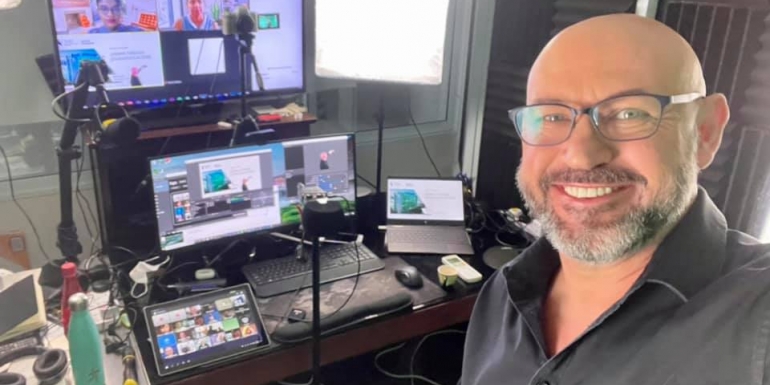TECH or CRAFT?
This debate is raging in the Professional Speaking Community.
For me, excluding relevant content, the argument isn’t either/or but ‘AND’.
Before Covid, I spent over 20-years developing the ‘craft’ of speaking. I studied and practiced storytelling, improv theatre, standup comedy, audience engagement, stage dynamics, vocal techniques, visual design, gestures, and pauses.
When virtual events became a necessity, I was already prepared to adjust craft to merge with tech. I learned to use Open Broadcast Software, audio mixing, and microphone specifications. I familiarized myself with all of the virtual platforms, not just Zoom.
Why did I do this?
Because that’s what a professional does. Become the best for your clients.
Becoming a Virtual Speaker
I don’t call myself a futurist, but I have been predicting disruption for the speaking industry for some time. check out my APS Convention Keynote from 2019.
With this in mind, I began to set up the means to deliver inspiration and information remotely from my computer and cloud-based software, way back in 2017. Now it’s 2021 and I am glad I had the foresight and self-leadership to disrupt before being disrupted.
With a 2-PC setup, I can broadcast leadership speeches, workshops, and coaching anywhere in the world. It’s now not unusual for me to start my day coaching on the East Coast of the USA, facilitate a meeting in Silicon Valley, speak somewhere in Asia and finish my day in India, Africa, or Europe.
All of this was possible before the 2020/21 Pandemic, but clients wanted in-person events and meetings.
Everything I needed to learn about being a Virtual Speaker was on the TV every night, and easily learned from YouTube, and my teenagers!
TV understands the concept of broadcasting and my kids had learned about broadcast software at school and introduced me to OBS. OBS is open broadcast software and is free. OBS allows you to prepare your presentation and broadcast it via a ‘Virtual Camera’ to any of the Virtual Meeting Apps.
With Broadcasting, you start with a scene and then add sources, such as video, audio, slides, images of movies. A scene allows you to ‘frame’ your content of the message and smoothly transition from one frame to another,
A great way to bore your virtual audience is to slide share. You are feeding them ‘death by PowerPoint’ and you are not even in the room to see them nodding off! Instead create a scene in your broadcast software with you, as captured by your camera, and your slides behind you, just like they do on TV. This way you, as the speaker, are the ‘star’. Your slide deck becomes the support act or ‘backing singers’.
If you need to share a lot of visual information, you can have another scene, where your image is smaller, so that you can show more of the slide real estate. The limit to the number of scenes is your imagination, and changing scenes keep the audience engaged.
Human engagement occurs with eye contact. By setting up your broadcast intentionally, you can look directly at your audience members, and when you ask a question, they feel you are asking them specifically.
I have a multi-screen set-up so that I can see my audience, providing they turn on their webcams. Getting people to turn on their cams is a sensitive issue as some people are embarrassed that they are showing their home environment, but I ask the meeting organizer to encourage them to do so.
Quizzes, polls, virtual whiteboards, and break-out rooms are essential for people to feel part of the event and to embed the learning.
Tell me and I forget. Teach me and I may remember. Involve me and I learn. – Benjamin Franklin
Social Networking is an important part of learning and reinforcement. Since the beginning of Covid, I have spoken at conferences, where the organizers have used platforms with ‘meet-up’ rooms and other ways participants can connect and share information. People love this, and until we can fully meet again, I would encourage speakers and organizations to keep an eye on the latest virtual connection technologies.
You will experience this at the APC 2021 – See you there!



